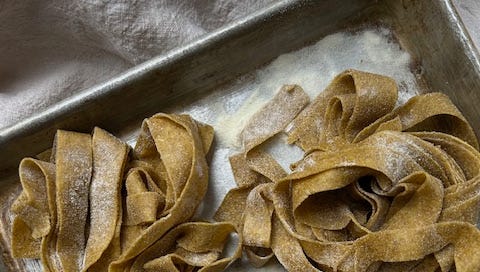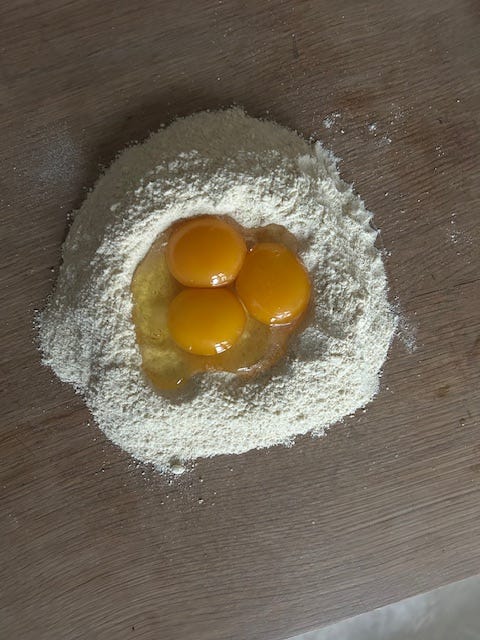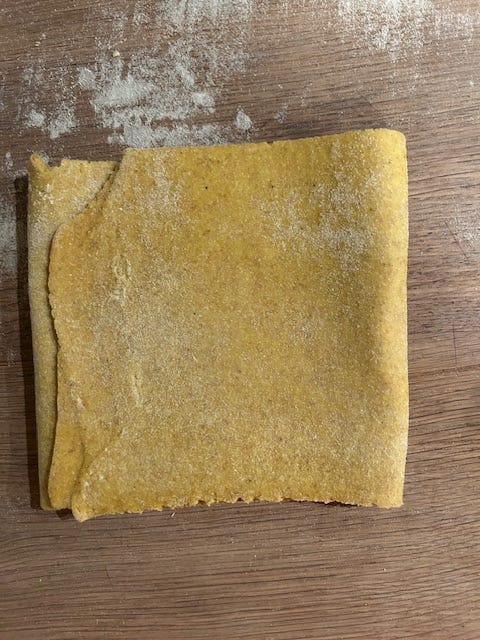Holiday Season Blues: Healing in the Kitchen
How the ritual of cooking & connecting can reframe seasonal depression
Spoiler alert: the holidays, as joyous and celebratory as they are, are always a pretty tough and lonely time for me, and for a lot of us1. But perhaps there’s a bit of mental repositioning we can do, and in many ways, it starts in the kitchen with what we feed ourselves and our loved ones, and how we are connecting to our food.
I’ve been wanting to open this newsletter up more and more to broader food x wellbeing topics and the Christmas week presents an ideal time to unveil the solitude of holiday seasonal depression. I do not have an an easy time opening up and sharing personal things like this, but I’m guessing I’m not alone, and I’m working on being more vulnerable and offering up more of myself on this platform (and in life), outside of simply recipes, to hopefully hit on topics that a lot of us struggle with. I figure I should probably put all those years of counseling others as a nutritionist with a background in cognitive behavioral therapy and intuitive eating to a broader use, so here goes…
No matter how you spend the holidays, with family, with friends, on your own, its a time where life takes a little pause and that can usually bring up reflection and feelings of solitude and loneliness (even when you’re surrounded by a dozen+ members of your immediate/extended/chosen family - insert the extremely stressful, chaotic and emotionally captivating “Fishes” episode from the Bear, season 2 - god damn it’s a great episode).
All the celebrating, hinged around food, alcohol and way too many Christmas cookies, can lead us into a deep spiral that rolls right on through New Years when we rise from a haze on January 2 and kick off the antidote of (mostly) short-lived New Year’s resolutions. In the days between Christmas (or Hanukkah, Kwanzaa) and New Year’s, when the gatherings quiet and we’re left to sit with ourselves, that’s when the reality of quiet itself sinks in. Very loudly. But what if we reframed that quiet and looked at it through the lens of reflecting on the year prior with calm and sensitivity so we can move into the year ahead with confidence and awareness and care. For so many years, I would beat myself up about using this “week in between” to be quiet, to rest, to organize, to read and write and just think — and to cook. I was making a choice to see the negative side of feeling a little lower, slower and more pensive—focusing on self-doubt, on the things in my life I still didn’t have or hadn’t achieved yet again in the past year, and how I envisioned spending my holidays vs my current reality. The fact that I’m sitting writing this in Denmark looking out a window of perpetually cloudy grey skies does not make seasonal dips any easier (I’ve learned that vitamin D deficiency is for realll the past few years). But I also recognize that sitting with melancholy, and a big as* bottle of vitamin D supplements, can bring about positive shifts if we allow it to.2 Those shifts, emotionally, mentally and physically, can and should start in the kitchen. Why? Because, cheesy as it may sound (and you’ve likely heard this a zillion times over), but how we can for ourselves on the inside massively reflects our outward appearance, attitude and ability to show up the way we want to in this short, wild and precious life (very lite Mary Oliver reference there).
So in the next few days, over the weekend, into the new year, here’s a couple of quick ways to shift seasonal moods through your food.
It’s quiet, take the time to listen to your body & recognize patterns around what you are (or aren’t) eating & drinking. here’s a few of my own I’ve been working on.
Coffee on an empty stomach first thing in the AM. If caffeine / coffee sets you off first thing in the morning (or later in the day), give your body a buffer with a lite breakfast or snack. Caffeine has lots of health benefits, but if you’re sensitive (like I am) and are drinking it on an empty stomach, it can also spike cortisol levels, speed up digestion and dehydration and throw delicate hormones off balance and impact sleep quality — so if you find yourself sweating more, running to the bathroom, a little shaky, having a blood sugar spike and fall from a strong cup …these are signs you might want to ease up and get off that emotional rollercoaster. And full disclosure: I am very routinized and love coffee before anything else, but peeing like 6 times before 12noon is generally not ideal. I definitely feel the difference of eating something balanced (a little protein, a little fat, some good carbs) before I take that first sip which helps stabilize my blood sugar and ease in a caffeine hit. Quick takes like a smoothie spiked with nut butter, nuts/seeds, some greens and fruit; an egg & avocado or sauteed greens; full-fat yogurt, fruit and granola can help create a buffer before your coffee.
What foods makes you feel your best cause metabolism hits wayyy different in your 40s. If you’re over 40, you know what the F I’m talking about and it kind of blows. But it also makes you appreciate the value even more of what you DO put in your mouth. It better taste damn good and it better the best quality possible, because at this age, we need to get even more bang for our buck from what we’re cooking and eating. Savor every bite, because we simply don’t need to eat as much anymore. Try to pinpoint, simply by tuning into your body’s cues, what foods and what quantities feel super good for you, (at whatever cycle you are in life)? What keeps your mood steady, or elevated, what keeps your blood sugar balanced, energy levels running strong, digestion running smoothly? All of this comes back to how we emotionally feel throughout the course of the day. Everyone has particular patterns that work well for them. What works for me, may not work for you. Take a few seconds before and after meals to pause and tap into your body, noticing any communication and what foods your body is asking for, or what foods you just ate and how they make you physically and emotionally feel. Usually, when left to its own devices, our bodies will crave pretty healthful foods and more fruits and vegetables than you may think. And if you are over 40, you’re gonna need to pop in some more good sources of protein (meat, fish, dairy, eggs, legumes, nuts and other plant-based sources), which helps maintain muscle mass and keep mood/blood sugar balanced.
Foods rich in vitamin D
Honestly, I don’t think you can (or would want to) eat nearly enough of any of these to really boost your vitamin D levels if they’re slumping, but here’s a quick list (vitamin D has been proven to improve seasonal depression and anxiety3): egg yolks, salmon/fatty fish, liver (yum, seriously!), mushrooms, cheese. Sunshine signals us to naturally produce vitamin D, keeping our moods steady. So if you’re living in a place where it’s quite dark and grey during winter (aka Scandinavia), 1. consider getting your levels tested and 2. consider a good vitamin D3 supplement of at least 10-15mcg — for reference, I’m currently taking 35mcg and it still doesn’t feel like its enough!
Routine & ritual
Having a typical daily routine around eating can directly impact mood. Wait too long to eat in the morning or in between meals and your mood can crash or create more anxiety and stress. You’ve already got enough of that from the holidays [insert The Bear video reference again]. Ritualizing practices (like the little early morning nutrient-packed smoothie I’ve been slamming just before my coffee), a handful of go-to easy lunches, an afternoon cup of tea, cooking something nice for yourself every Sunday evening - among other examples, all these things help steady emotions and keep you engaged in the kitchen and with what you’re consuming. There’s something extremely grounding, calming and satisfying in the ritual of cooking and connecting with your food. What do you recognize if you keep notes around that for a few days? Does your mood shift?
Investing in the time to cook something (new or old) that brings comfort and joy, and maybe a new skill
If you’ve got a quiet week, make use of it. Make something that excites and fills you up in some way (not just literally), but with joy or a new flavor or nostalgia. Food, similar to people, matches the energy we exude and when you’re feeling low, you can give yourself an easy bump by caring for yourself through preparing a meal, simple or detailed as it may be. Don’t overthink it, just get yourself into the kitchen. Even basic scrambled eggs can be mood lifting and creamy, sexy delicious.
The satisfaction of using your hands and making something from scratch
Take the task at hand a little farther and invest your time in making or baking something homemade and using your hands. There’s unspoken energy that is so so soothing and uplifting in working with your hands and making something delicious from scratch. The homemade pasta dough recipe down below is a great example of this, making and kneading the dough with your hands is almost meditative and a bite of fresh pasta—tender yet toothsome and actually flavorful—that’ll boost up endorphin levels basically immediately. Side note: The recipe also excellent if you find that store-bought pasta upsets your stomach/digestion…using a locally-sourced or good quality flour makes a crazy, crazy difference in the gluten to bloat quotient if you’re someone who struggles with that, my hand is currently raised.
Sasonal ingredients meet our bodies seasonal needs
Lastly, mother nature does things for a reason. The cycles of seasonal produce, and the nutrients they provide, relate directly to our nutrient and metabolic needs at varying times of the year. In the northern hemisphere, the air is dry, crisp and cold right now. We require heavier, more stabilizing foods that give us a sense of comfort and warming and a boost of endorphins and serotonin (less light means more dips in our mood). Trust in nature and look to seasonality (and if you can find local vegetables and other ingredients, even better). If you’re unsure of what items are in season in your area, google it, or generally winter gives us kind of a slim picking, but enough to get us through the colder months with some resourceful creativity: root vegetables (potatoes, pumpkins, parsnips, beets, turnips, Jerusalem artichokes), dark leafy greens (chicories, chard, kale, collards), cruciferous veg (like cauliflower, brussels sprouts and broccoli if they haven’t already frozen over), onions and leeks. Most of these items need to be prepared warm, roasted, braised, stewed, grilled, sauteed…I’ll stop there, but warming foods make our bodies and our moods warm and content and cared for. Enough said. *Oh and a, late but no less worthy addition…citrus fruits! Eat them fresh, cook with them, squeeze them into hot water, or even just smell them…instant mood lifter.
So if nothing else, take care of yourself (and those around you) this winter season…and make some fresh pasta—pretty positive you’ll be glad you did.
Fresh Hand-Cut Egg Pasta
for pappardelle, fettuccine, tagliatelle etc can be made with or without a pasta machine
200g ‘00 or all-purpose flour
200g soft wheat flour like einkorn (if you can source einkorn flour it gives the most gorgeous nutty, buttery flavor and creamy texture, I was floored). If you’re based in Denmark and you’re reading this, check out Vild Hvede for their golden einkorn flour. If you’re in NYC / east coast, check out River Valley Community Grains.
50g semolina flour
8 egg yolks (144g)
3 whole eggs (90g)
In two separate bowls, whisk flours together / lightly whisk eggs together. Pour flour mix on the countertop and make a well. Pour in egg mix (pre-whisking helps prevent overspill of the eggs breaking the flour barrier). With a fork, gently start working in the inner ring of flour in a circular motion. Continue to incorporate the flour. If the flour barrier breaks, use a bench scraper to catch it and fold it back into the flour. Work together until a “batter” forms and then on a lightly floured surface, knead the dough, in a rocking motion and turning it in a 180 degrees, folding it over itself and fold and press down again. Add a teaspoon or two of water or a sprinkle of flour as needed depending on how the dough feels. Knead it for about 8 to 10 minutes until its smooth and firm like a ball of playdough (or a baby’s bum) - if you press your finger into it gently the dough should bounce back. Then you know you’re done. Wrap the dough in plastic and let it rest 30 minutes and then you’re ready to roll it out. Alternatively, after resting, refrigerate the dough overnight and remove it about 30 minutes before you’re ready to roll. If you’re not sure about the kneading motion, here’s a great video to watch from Pasta Social Club.
If you’re rolling out with a pasta machine/sheeter, follow its instructions. If you’re going full-tilt tactile with a rolling pin, make sure your surface is nicely floured. After rolling/sheeting, cut the pasta in the width you desire, sprinkle pasta bundles with a bit of semolina and keep them covered with a clean kitchen towel while you continue to work and are ready to boil off (boiling water, salty like the ocean, until al dente tender, 2-3 minutes max).
Spending time alone can help manage depression during the holidays








